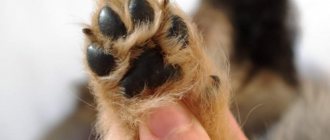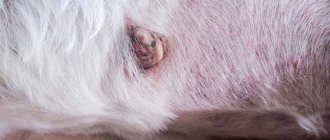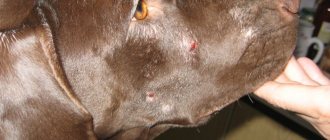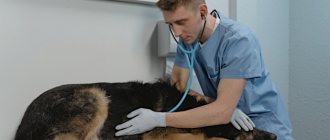Pododermatitis in dogs is an inflammatory process of the interdigital spaces or pads on the animal’s paws. It is classified as a secondary pathological sign of an autoimmune malfunction in the dog’s body. Taking into account the specifics of the onset of the disease, each case of pododermatitis must be differentiated as an individual case.
Pododermatitis in dogs
Pododermatitis is an inflammatory process in the interdigital space and around the paw pads. It occurs as a result of infection or is aseptic inflammation, expressed in discomfort, severe pain when moving. The dog instinctively presses its paw, tries not to step on it, and licks the affected area.
Clinical picture
In general, some “problems” with the paws can be noticed immediately: your dog constantly licks or even chews his paws, and lameness soon develops . Interdigital cysts are thought to be most common in young animals under four years of age. Practice proves that Staffordshire terriers and bull terriers, as well as retrievers, are most often affected. Regardless of gender and breed, all pets with congenital or acquired pathologies of the musculoskeletal structure of the limbs are at risk. A physical examination can immediately reveal: dorsal (on the top of the foot) interdigital erythema (redness), swelling, nodules and papules, wet and foul-smelling areas.
Why does the disease occur: the main reasons
Pododermatitis can occur for the following reasons:
- Damage to the skin, cracks on the pads of the paws.
- Bacterial infections (streptococcus, staphylococcus, Proteus, etc.), inflammation occurs more often against the background of decreased immunity.
- Systemic disorders (periarthritis nodosa, thrombocytopenia, etc.).
- Parasitic diseases, external and internal (fleas, ticks, worms).
- Fungal infections (ringworm).
- Allergic dermatitis. It is often observed in winter, when walking through snow sprinkled with reagents.
- Diseases of the endocrine system (diabetes mellitus).
- Oncological diseases.
Initially, most diseases can manifest themselves in the same way - redness of the skin in the interdigital space, inflammation and anxiety of the pet. The exact cause of symptoms can only be determined after a thorough examination at a veterinary clinic.
Characteristic symptoms
Signs of pododermatitis most often appear on the front legs.
What you can see:
- severe redness of the skin;
- formation of pustules;
- formation of nodules.
Nodules, blisters, fistulas, bald spots and areas of skin with severe swelling are visually visible. Often the paws become itchy, which causes the dog to constantly lick them and further intensify the symptoms.
With a strong inflammatory process, lameness and enlargement of nearby lymph nodes may appear.
How does the disease manifest itself?
The manifestation of pododermatitis can be general and specific, it all depends on what underlies its occurrence. Common manifestations of the disease include:
- Swelling, redness in the affected skin area.
- The dog limps and, if severely injured, stops walking.
- Anxious, the pet licks the area of inflammation, causing even more swelling.
- On palpation, the pad and interdigital space are very painful.
In advanced cases, abscesses, fistulas and wounds appear. In the presence of a bacterial infection, ulcers and ulcers appear, the skin in the area of inflammation is hot, and the overall body temperature may increase.
When paws come into contact with chemical reagents, skin redness and inflammation appear. Severe itching occurs at the site of the lesion; due to constant scratching, the configuration of the fingers is smoothed out, they are difficult to distinguish.
Constant licking of the affected area leads to alopecia (lack of hair), the skin is damaged, non-healing wounds appear, because the dog does not allow them to heal.
Conclusion.
Prevention of interdigital dermatitis involves generally maintaining the health of the dog’s body. To do this, it is necessary to feed the pet properly and fully, give regular physical activity, and maintain a comfortable mental state of the pet. The best way to prevent infectious diseases is regular vaccination. As for parasitic diseases, monthly treatment with insecticides and quarterly treatment with anthelmintic drugs are required. If you notice signs of inflammation on your pet's paws, you should immediately show it to a veterinarian. Local treatment will not be effective unless the correct diagnosis is made. Moreover, it can even worsen the situation.
How is the disease diagnosed?
It is possible to make a correct diagnosis and identify the true cause of pododermatitis in a dog only with a full examination at a veterinary clinic. Often the disease manifests itself as secondary, against the background of other pathologies.
What events are held:
- General blood and urine analysis.
- Scraping for demodicosis.
- Examination for the presence of skin parasites.
- Testing for fungal infections.
- Allergy tests.
- Cytological examination.
Often dog owners refuse examination, believing that it is enough to give pills or use ointments to eliminate the disease. But this is a wrong opinion. Only identifying and making an accurate diagnosis will help prescribe the correct treatment and act directly on the cause of pododermatitis. Eliminating only visible symptoms will lead to regular relapses and endless use of medications without results.
Diagnostics
In order for the treatment of pododermatitis to be as successful as possible, it is necessary to accurately confirm the diagnosis. To do this, a cytological examination of the purulent focus is carried out. With pododermatitis, staphylo- and/or streptococci and bacilli are found in smears.
When examining tissues, areas of pus, boils, and follicles are found.
If a dog is suspected of having pododermatitis, it is examined and diseases similar in clinical picture are excluded:
- Maassesial (yeast fungus) dermatitis.
- Demodecosis.
- Actinomycosis.
- Mycobacteriosis.
Tumor processes and autoimmune diseases must be excluded; each pathology on the list has symptoms similar to pododermatitis, but they must be treated differently.
Features of treatment of pododermatitis in dogs
Treatment depends entirely on the final diagnosis made by the veterinarian during the examination. The form of pododermatitis is also taken into account - aseptic or bacterial.
When aseptic (without the presence of pathogenic microflora), the damaged surface of the paws is mechanically cleaned, dirt, glass, pebbles, etc. are removed. The skin and paw pads are treated with aseptic/antibacterial solutions, which are necessary to prevent the introduction of bacteria and the occurrence of suppuration.
Treatments are carried out at least 2-3 times a day, as soon as the wounds begin to heal, the use of aseptics is reduced to 1-2 times a day or 2-3 times a week. The frequency of treatments is entirely individual and depends on how quickly healing occurs.
If a bacterial infection is present (suppuration, severe inflammation), then a course of antibiotics must be prescribed to eliminate the possibility of sepsis (blood poisoning). In addition, they regularly clean the affected wound, treat the skin, and the interdigital space. Treatment lasts until the symptoms disappear completely and the dog becomes more active.
A pet with pododermatitis is usually at home. Treatments and injections are also carried out at home by the owner or by inviting a veterinarian or visiting a veterinary clinic.
Cracks or broken claws
The problem appears if, after an injury to the paws or claws, the dog is not given timely help. The dog limps and whines when examined, and there is suppuration or a nail falling off in the paw. To avoid its complete loss, softening compresses with oil are made, and the claw is treated with antiseptics.
Treatment
It is eliminated by removing the cutting end of the nail or crack with a sharp knife, then the cut area is covered with epoxy resin. This way you can save your pet's claw. If the base of the claw is damaged, it is treated with an antiseptic, then dried and coated with iodine. Then the burrs and broken claws are cut off with scissors and coated with streptocide or a mixture of manganese and boric acid. Aerosols are also suitable - “Ungutil” or “Kubatol”. After treatment, a protective bandage is applied to the paw.
Aerosol "Kubatol"
Disease prevention
Preventive measures are based on preventing the causes of pododermatitis. Based on this, the owner must exclude any injuries in the area of the paw pads and the interdigital space. To do this, avoid walking the dog in places where it can step on glass, sharp stones, etc. In winter, especially in large cities, paws should be protected from contact with reagents. To do this, wear special boots for dogs or lubricate them with protective agents that prevent chemicals from entering the skin.
After each walk, it is recommended that dogs wash their paws and inspect them for wounds.
The pet should be regularly vaccinated, treated against parasites, and protected from fleas and ticks. Provide a complete diet, exclude foods and feeds that cause an allergic reaction.
Preventative examinations at a veterinary clinic twice a year will help to identify possible diseases in a timely manner. A quick visit to the clinic at the first symptoms of pododermatitis will eliminate the disease as soon as possible and eliminate the occurrence of complications.
Preventive measures
You need to keep an eye on your pet. After a walk, the paws should be washed and disinfected, and the hair between the toes should be trimmed.
- You need to watch what your dog eats. Nutrition should be complete and balanced.
- If your four-legged animal is kept in a kennel, you should clean it regularly.
- It is important to pay attention to any changes in behavior and, if necessary, take your pet to the clinic.
- If the cause of the disease is an allergen, it should be eliminated.
The therapy must be correct. Medicines are prescribed by a doctor, but dosages should not be exceeded. If your pet has an allergy, you should inform your veterinarian.
Currently reading:
- Seven Signs and Remedies for Getting Rid of Fleas in Dogs
- Thyroid dysfunction in dogs (hypothyroidism)
- The American Cocker Spaniel is an adroit hunter and loyal friend.
- How to recognize signs of dog poisoning from rat poisons
Cushing's syndrome
LOCATIONS
Cushing's syndrome in dogs or hyperadrenocorticism is one of the most common diseases of the endocrine system in dogs, which occurs when excessive production of the hormone cortisol by the adrenal glands (located in the abdominal cavity) or adrenocorticotropic hormone by the pituitary gland (located in the brain).
Symptoms:
- Increased thirst and urination.
- Increased appetite.
- Obesity.
- Skin changes may be characteristic (alopecia without signs of itching, thinning and inelasticity of the skin, comedones).
— Muscle weakness/wasting, sagging abdomen (“pot-bellied” appearance).
— Disturbance of the reproductive cycle in females and atrophy of the testes in males.
- Noisy and rapid breathing.
— Neurological signs.
Treatment:
1. Drug treatment in the form of tablets (ketoconazole, mitotane, etc.).
2. Surgery (for unilateral adrenal tumor).
===========================================================================================================================================================================================
Symptoms
Primary signs of a pet's painful condition are accompanied by lameness, a tendency to passivity, loss of interest in games and the dog's increased attention to the diseased part of the body. A detailed examination of the paws reveals the following manifestations of the disease:
- redness;
- swelling of the affected area;
- itching;
- necrotic processes (tissue death);
- hair loss;
- ulcers on the skin between the fingers;
- formation of abscesses;
- presence of seals;
- change in the natural color of the pads;
- increase in general and local temperature.
It is not necessary that all symptoms appear at once, as they are determined by the causes of the development of dermatitis.
For example, the allergic form does not involve purulent formations and ulcers, but the inflamed tissues turn red, swell and itch. At the same time, it is possible to differentiate infectious dermatitis from hormonal one only by laboratory methods, since they have a similar symptomatic picture.
Risk group
The risk group for the development of dermatological diseases includes:
- puppies up to six months of age;
- elderly pets;
- animals with weakened immune systems;
- pets who have undergone surgery or acute infectious diseases;
- dogs undergoing serious drug treatment;
- animals receiving poor quality nutrition;
- pets in contact with untested or stray animals;
- animals living in unsanitary conditions.
Parasitic dermatitis
Therapy for parasitic dermatitis is selected taking into account the microorganism that caused the disease.
- If sarcoptic mange is observed, the affected skin surfaces are treated with insecticidal and acaricidal agents.
- For damage caused by the Demodex canis mite, therapy is long-term and is selected taking into account the characteristics of the dog’s condition.
- Anthelmintic drugs are used for hookworm infections caused by the parasites Ancylostoma caninum and Uncinaria stenocephala.
Worms, mites and other parasites can cause interdigital dermatitis.
Flea infestation
Symptoms:
- The dog is constantly itching, all over, here and there. The scratch is very characteristic: fast and furious.
- The animal sleeps poorly and nervously wanders around the apartment in search of relief from the unbearable itching. The dog becomes irritable and restless.
- A characteristic sign of a dog being infected with fleas: the pet begins to sharply bite into the skin, clattering its teeth, trying to catch the irritant.
- In advanced cases, the dog may develop an allergy to fleas. The eyes begin to water, the skin becomes covered with a rash, small blisters and pustules that burst and form ulcers and scabs. The animal can scratch such formations until there are bloody wounds and bald patches.
- If treatment is not started in time, fleas will lay eggs in the animal’s fur. They can be easily seen. But in this case, dogs with dark colors, so to speak, find themselves in a more advantageous situation. The fact is that flea eggs are light grains, in appearance somewhat reminiscent of grains of rice, only much smaller. The size of the eggs does not exceed one millimeter.
- If you run your hand over a dog’s fur, then in addition to fleas, larvae and eggs quickly hiding and escaping in the undercoat, you can see dark grains (parasite feces) on the animal’s fur.
- If it is difficult for the owner of a four-legged dog to determine whether his pet has fleas, then the best way to identify insects is to run a bath of water and bathe the dog. Upon contact with water, fleas will begin to move onto the animal’s head or jump into the water.
Treatment:
1. Bathe the animal with flea shampoo.
2. Sanitize the pet’s bedding and the entire room.
Prevention:
- Drops against fleas.
— Antiparasitic collar. ===================================================== ===================================================== ===================================================== =====================================================
Redness between the pads on the paw
Typical for hunting and service dogs. Occurs due to a long run over rough terrain, frozen ground, icy snow, or a road with coarse sand. Symptoms include the dog’s refusal to move; when walking, the animal does not want to lean on a limb. Abrasions, wounds and scratches are noticeable on the pads; burns are possible due to contact with lime, boiling water, acid or alkali. Severe cases are characterized by skin sloughing and non-healing ulcers.
Therapeutic techniques
In most cases, a secondary bacterial infection is present, and therefore the animal is prescribed broad-spectrum antibiotics. If the deep layers of the skin are affected, the treatment period can reach two to three months.
The worst thing is if a fungal infection of the skin of the paws was detected. Drugs for the treatment of mycoses are expensive, and the treatment period can reach six months or more. In severe cases, the claws have to be completely removed. For sick dogs (you should discuss this with your veterinarian), affected paws should be washed regularly with antiseptic solutions.
Pets are given plenty of essential fatty acids (with fish oil), and severe inflammation can be treated with glucocorticoids. In the case of a fungal etiology of the process, the latter are prescribed extremely carefully, since steroids, when taken for a long time, strongly “impair” the immune system and contribute to the development of the same fungal diseases.
Allergies and urticaria
Allergies are caused by common house dust, pollen, dog shampoo, food, tobacco or mold. Symptoms of the disease are individual for each pet. Some people are limited to a runny nose and red eyes, while others suffer from unbearable itching and rashes.
Hives are a type of allergic reaction. It is characterized by the appearance of round or oval plaques, as well as redness and thickening of certain areas of the body. These formations are very reminiscent of a burn after close contact with nettles.
The most dangerous manifestation of allergies is Quincke's edema. It is accompanied by extensive swelling, an attack of suffocation, and pale or blue discoloration of the mucous membranes. Without timely assistance, the animal risks dying, so it must be taken to a doctor immediately.











